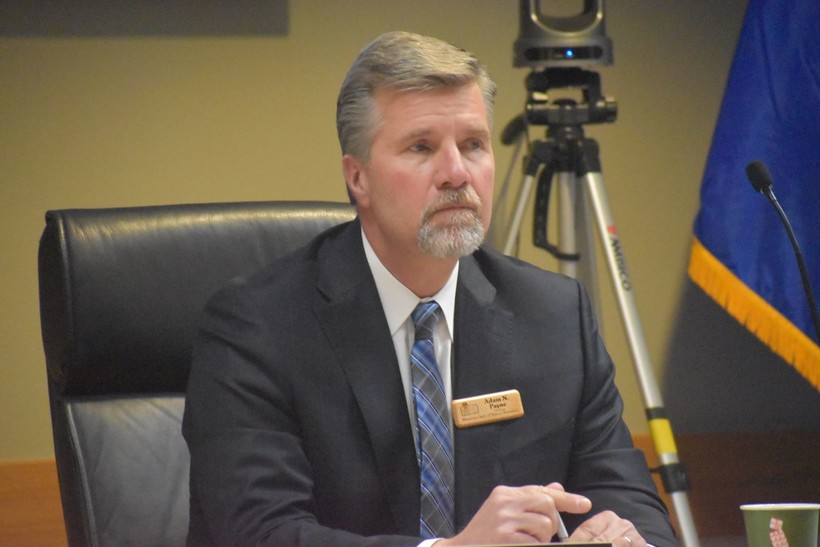DNR Leader Says State Budget Needs More Money For Clean Water
Republican-controlled Legislature will determine funding, with some members indicating support.

Wisconsin DNR Secretary Adam Payne at a Natural Resouces Board meeting on Feb. 22, 2023. Danielle Kaeding/WPR
The head of the Wisconsin Department of Natural Resources said the Republican-controlled state Legislature should provide more funding than what’s proposed under Gov. Tony Evers’ budget to help communities address PFAS contamination.
DNR Secretary-designee Adam Payne made the remarks Tuesday as part of a day-long workshop for local government leaders on PFAS. The conservation group Wisconsin’s Green Fire hosted the event, which was broadcast on WisconsinEye.
Evers has proposed more than $100 million to address PFAS largely through a grant program that would help communities investigate and respond to contamination. GOP lawmakers stripped hundreds of items from the governor’s budget this week, including several PFAS provisions. Even so, Payne noted funding to combat the harmful forever chemicals was not among items removed. He urged attendees to contact lawmakers to ensure funding for PFAS remains in the budget.
“It’s a little over $100 million. It should be more than that,” Payne said. “Not less, but more.”
Some Republican lawmakers have indicated support for funding efforts to address the chemicals, including Sen. Mary Felzkowski, R-Irma, and Sen. Rob Cowles, R-Green Bay. Republican Sen. Howard Marklein, co-chair of the state’s budget writing committee, said Thursday that lawmakers have not addressed PFAS in the budget yet.
“That’ll be coming up in coming weeks,” Marklein said. “We’re certainly aware of the issue. In terms of how much we fund, where we fund, I guess that’s to be determined yet.”
PFAS, or per- and polyfluoroalkyl substances, are a class of thousands of synthetic chemicals used by industry since the 1940s. They’ve been found in everyday products like nonstick cookware, stain-resistant clothing, food wrappers and firefighting foam. The chemicals don’t break down easily in the environment. Research shows high exposure to PFAS has been linked to kidney and testicular cancers, fertility issues, thyroid disease and reduced response to vaccines over time.
The Environmental Protection Agency has proposed drinking water limits of 4 parts per trillion for the two most widely studied PFAS chemicals, which is 17 times lower than the state’s current drinking water standard of 70 parts per trillion. Groundwater standards for private wells are currently lacking, although the DNR is crafting limits for the chemicals. Around a third of state residents get their drinking water from private wells.
The chemicals have contaminated both public and private wells in the towns of Peshtigo and Campbell in addition to the cities of Wausau, Eau Claire and Madison. Some communities are seeking state and federal assistance as they face millions of dollars in infrastructure upgrades to address the chemicals. The DNR has confirmed around 80 sites with PFAS contamination and more than 100 investigations are ongoing.
Around 20 fish consumption advisories for PFAS have also been issued. That includes an advisory announced Thursday for anglers to limit meals of rainbow smelt from the Bay of Green Bay and portions of surrounding rivers.
As more communities discover contamination, the DNR unveiled a new toolkit this week to help community leaders and residents respond to PFAS. Local leaders of PFAS-polluted communities also shared their experiences and advice at Tuesday’s workshop.
DNR, local leaders talk best practices to address PFAS
When testing detects elevated PFAS levels, the DNR suggests communities conduct follow-up sampling to confirm results. Depending on the severity of contamination, local governments and water systems may want to communicate risks, identify a temporary and long-term solution, pinpoint the source and possibly upgrade or install infrastructure to provide safe water.
DNR staff urged community leaders to learn more about PFAS and establish relationships with local health officials, water utility managers and emergency management groups.
“So when it does hit your community, and it may, that you have a network that you’ve already established to work through that,” said Jim Zellmer, the DNR’s administrator of the environmental management division.
If contamination is found, the state may be able to provide temporary drinking water or funding for well replacement and upgrades to water systems.
Private well owners can receive up to $16,000 for replacing or abandoning wells under the state’s federally funded grant program. An additional $900 million in funds is available to communities through the DNR’s environmental loan programs as part of funding under the Bipartisan Infrastructure Law passed in 2021. Despite that, the DNR’s field operations director Kyle Burton said demand for funds will likely exceed available dollars.
“I don’t think that communities will get all the money they need to create a new public water system,” Burton said. “But there is money available to offset those costs.”
The city of Wausau has utilized state loans and federal funds to address PFAS contamination after testing revealed the chemicals in all six of the city’s wells. The city has installed a temporary solution at its treatment plan. Mayor Katie Rosenberg has said Wausau is seeking as much state and federal assistance as possible to fund a permanent solution. Residents are facing a 65 percent increase in water rates to help fund a roughly $17 million granular activated carbon filtration system to remove the chemicals.
“The last three years have been crushing, so asking people to do that is tough,” Rosenberg said.
The town of Peshtigo in northeastern Wisconsin had also been exploring the creation of a public water utility after PFAS stemming from Tyco Fire Products’ fire training facility contaminated private wells. Town estimates showed options for a permanent source of safe water may cost more than $91 million to build infrastructure, excluding ongoing operations and maintenance. The town’s former chair Cindy Boyle urged communities to get creative and not be afraid to “beg and borrow” for money.
In Madison, the city formed a multidisciplinary team in 2019 after shutting down a well contaminated with PFAS near the Truax Air National Guard base. Michael Mucha, director of the Madison Metropolitan Sewerage District, said the team was key to addressing contamination.
“It needs to be a full group of people that can look at a problem, such as PFAS, from multiple different angles,” Mucha said.
The city worked with environmental consultant TRC to evaluate treatment technologies so they can bring the well back online. Mike Ursin, senior project manager for TRC, said installing a granular activated carbon system was the most cost-effective way to reduce PFAS. The city plans to spend $5.9 million to install treatment equipment by summer of 2025.
At least three treatment methods are effective at removing PFAS from drinking water, including granular activated carbon, ion exchange resins and membrane filtration like reverse osmosis. Shalene Thomas is a global emerging contaminants program manager with the environmental engineering firm WSP in Minneapolis. Thomas urged local leaders to research whether treatment technologies have been NSF-certified, peer-reviewed and tested in the field.
She said many water utilities are using granular activated carbon to bring PFAS down to levels that will meet the EPA’s proposed standards. Beyond that, Thomas said communities will need to examine technologies to destroy waste from treatment methods and work to reduce or eliminate sources of PFAS.
Listen to the WPR report here
Head of DNR says state budget should include more money to help communities address PFAS was originally published by Wisconsin Public Radio.

















People all over our state cannot drink their own well water.
It’s time to hold those who dumped these toxic chemicals into
the water accountable. More funding is good.
Holding people accountable for poisoning the water is good too.
Fresh, clean water is everything.
3M and Tyco are responsible for vast quantities of PFAS in our water and soil. They must not be allowed to get away with criminal conduct for profit, but that’s the neo-republican way.